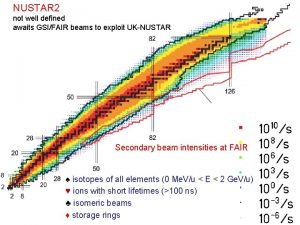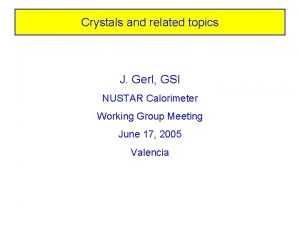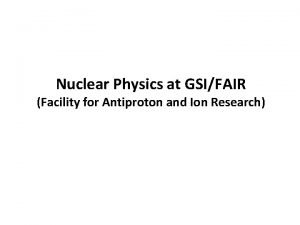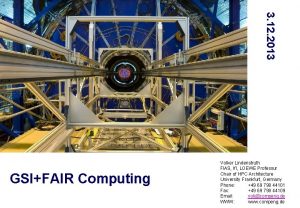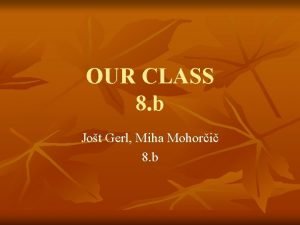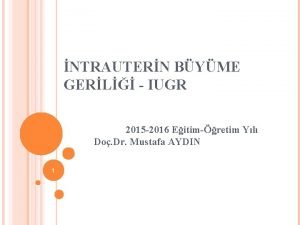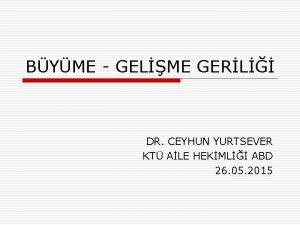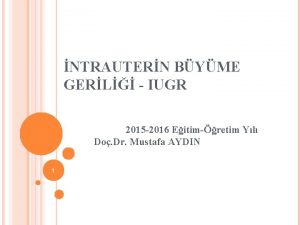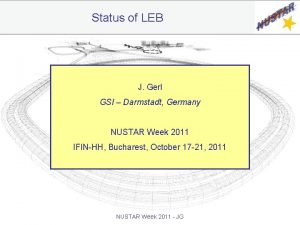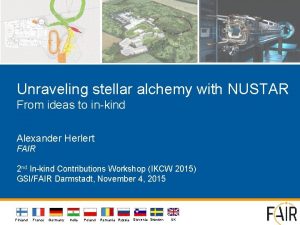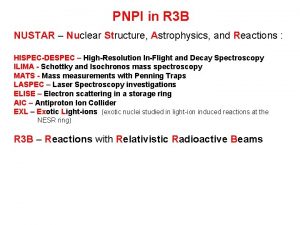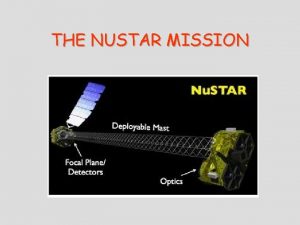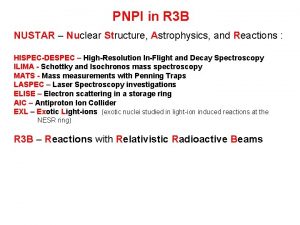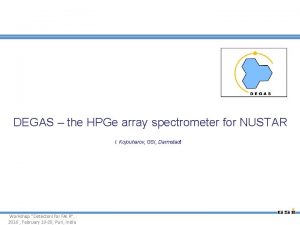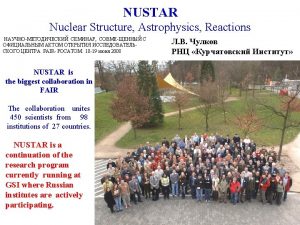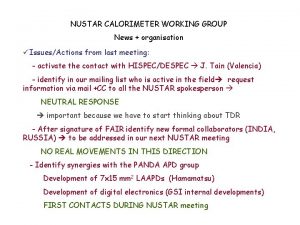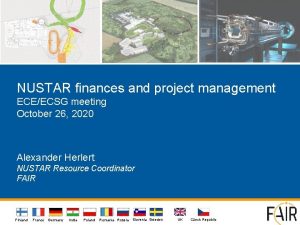The NUSTAR Physics Case Requirements J Gerl GSIFAIR























- Slides: 23

The NUSTAR Physics Case Requirements J. Gerl GSI/FAIR Darmstadt, Germany Slow Extraction Workshop Darmstadt June 2016

NUclear STructure Astrophysics and Reactions What are the limits for existence of nuclei? Where are the proton and neutron drip lines situated? Where does the nuclear chart end? How does the nuclear force depend on varying proton-to-neutron ratios? What is the isospin dependence of the spin-orbit force? How does shell structure change far away from stability? How to explain collective phenomena from individual motion? What are the phases, relevant degrees of freedom, and symmetries of the nuclear many-body system? How are complex nuclei built from their basic constituents? What is the effective nucleon-nucleon interaction? How does QCD constrain its parameters? Which are the nuclei relevant for astrophysical processes and what are their properties? What is the origin of the heavy elements? 24 2

NUSTAR - The Project DESPEC -, -, p-, n-decay spectroscopy ELISE elastic, inelastic, and quasi-free e--A scattering The Approach EXL light-ion scattering reactions in invere kinematics HISPEC in-beam spectroscopy at low and intermediate energy Complementary measurements leading to consistent answers ILIMA masses and lifetimes of nuclei in ground and isomeric states The Collaboration LASPEC Laser spectroscopy > 850 scientists MATS in-trap mass measurements and decay studies 184 institutes R 3 B kinematically complete reactions at high beam energy 39 countries Super FRS RIB production, identification and spectroscopy SHE 24 Nuclear physics and chemistry of super-heavy elements 3

Complementarity of NUSTAR experiments Super. FRS 24 HISPEC/ DESPEC LASPEC MATS R 3 B ILIMA SHE ELISE EXL 4

NUSTAR - The Project DESPEC -, -, p-, n-decay spectroscopy ELISE elastic, inelastic, and quasi-free Evolutionarye--A approach: scattering Advancing instrumentation continuous EXL light-ion scattering by reactions in developmentinvere and gaining kinematicsexperience by physics HISPEC exploitation in-beam spectroscopy at low and ILIMA The Approach intermediate energy Complementary measurements leading to consistent answers masses and lifetimes of nuclei in ground and isomeric states The Collaboration LASPEC Laser spectroscopy 800 scientists > 850 MATS in-trap mass measurements and decay studies 182 institutes 184 R 3 B kinematically complete reactions at high beam energy 38 countries 39 >50 instrumentation sub-projects (MSV) Super FRS RIB production, identification and spectroscopy several 1000 major components SHE 24 Nuclear physics and chemistry of super-heavy elements 5

NUSTAR Diversity R 3 B Start set-up HISPEC-DEGAS . . . Pluralities of modular detection systems 24 6

Status of realization GLAD LYCCA AGATA 24 Instrumentation is - in time - in budget - partially in use 7

NUSTAR - The Facility Low Energy Branch: HISPEC, DESPEC, MATS, LASPEC Sp ec High Energy Branch: /D EC SP HI LE MA EXL, ILIMA, ELISE B TS Ring Branch: ES & PE C La R 3 B Pre Separator Main Separator R 3 B RING HEB production target Beam intensity improvement: 102 to 105! ILIMA In addition: HESR, FRS, ESR 24 8

In-flight separation of Rare Isotope Beams § Primary (production) target § Peripheral nuclear reactions § Forward focused products Secondary (reaction) target Experimental area Electromagnetic separator 24 Stable HI projectile source Selected radioactive beam E >> 100 AMe. V E = 0 …. 1000 AMe. V 9

Projectile fragmentation or fission in radioactive isotopes production ? § § § 9 Be target exotic nuclei (also neutron deficient) fragments nearly retain the projectile direction and velocity Interaction zone § § § 208 Pb target, heavy beam (238 U) neutron rich nuclei fragments can be faster than the projectile Coulomb field 24 10

SUPERconducting FRagment Separator Transmission 24 11

Q =Z 95 % Uniqueness and Competitiveness • High energies for unique separation and unique experiments • Competitive intensities throughout the periodic table 24 Facility U beam int. per spill at production target previously at GSI 1. . . 2 x 109 after the SIS 18 upgrade at GSI 8 x 109 commissioning phase SIS 100 2 x 1010 final full intensity with SIS 100 3 x 1011 12

NUSTAR - Phases • Phase 0 – R&D and experiments to be carried out with present facilities (GSI and others) and FAIR/NUSTAR equipment (basic set-ups) • Phase 1 – Core detectors and subsystems completed – First measurements with FAIR/Super-FRS beams Ø Carry out experiments with highest visibility as part of the core program and within the FAIR MSV (“day-1”) • Phase 2 – FAIR evolving towards full power – Completion of experiments within MSV Ø Essentially the full program of MSV can be performed • Phase 3 – Moderate projects, which have been initiated on the way (outside MSV) can be included (e. g. experiments related to return line for rings) • Phase 4 – Major new investments and upgrades for all experiments 24 13

Highlights of the initial Phase – 1 programme 24 • Understanding the 3 rd r-process peak by means of comprehensive measurements of masses, lifetimes, neutron branchings, dipole strength, and level structure along the N=126 isotones; • Equation of State (Eo. S) of asymmetric matter by means of measuring the dipole polarizability and neutron skin thicknesses of tin isotopes with N larger than 82 (in combination to the results of the first highlight); • Exotic hypernuclei with very large N/Z asymmetry. 14

The N=126 Physics case Previous GSI measurements contradict earlier lifetime predictions! → Mass abundances not understood! GSI old T 1/2 predictions new T 1/2 predictions 24 oin ng p t i ait w 3 rd path r-process Mass abundances depend on the detailed structure of N=126 nuclei around the 3 rd r-process waiting point Phase-0 Phase-1 Phase-2 ue N T S U R A NUSTAR aims to measure: iq nt n u e -masses t m i n r a -β-lifetimes rt pe o -neutron-branchings p ex Im EB -strength distributions L -level structure 15

NUSTAR time line 2015 2016 2017 2018 2019 2020 2021 2022 2023 commissioning operation civil construction NUSTAR experiments construction and operation „outside“ FAIR installation Phase 1 NUSTAR caves Phase 0 Super-FRS construction and installation commissioning operation at FAIR 16 24 16

Primary Beam Requirements General Requirements Elements: Any! Often requested is Ar, Kr, Sn, Xe, Pb, U) Isotopes: As heavy or as light as reasonably possible Intensity: As high as reasonably possible Typical experiment Combining several runs using one particular isotope Tuning and bug fixing: 1 -2 days Production run: 24 2 -10 days 17

Beam transport primary beam secondary beam fixed target storage ring 24 18

Beam Cycle for Fixed Target Experiments Spill structure: Spill length: 0. 5 s to 8 s Off spill length: as short as possible 24 19

Coarse Spill Structure at FRS S 4 hits /100µs 3 s spill 23 k. Hz Coarse spikes with up to 100 x hits compared to the mean value per 100 us interval. Voids with up to 50% empty time intervals. multiplicity /100µs mean 2. 9 DAQ processing time: 100µs → Only 1 hit /100µs contributes. Spikyness reduces data acceptance by up to a facotor of 3 !!!!

Fine Spill Structure at FRS S 4 Fine spikes with up to 50 x instantaneous rate compared to mean rate. Severe overloading of particle tracking detectors!!!! Reduced detection efficiency and reduced resolution!!!! 24 21

Conclusions • NUSTAR is well advanced • The Phase 0 physics programme employing NUSTAR instrumentation is planned at SIS/FRS at GSI from 2018 onwards • The Phase 1 programme is planned at FAIR/Super-FRS as soon as the facility will become operational • To be competitive a wide variety of primary beams at highest possible intensity is required! • Currently the spikyness of the spill structure of SIS beams reduces the usable intensity by a factor 3 -5! • The fine structure of the spikes reduces the efficiency and resolution of the detectors considerably! 24 22

. . . thank you 24 23
 Nustar uon
Nustar uon Best case worst case average case
Best case worst case average case Modern physics vs classical physics
Modern physics vs classical physics University physics with modern physics fifteenth edition
University physics with modern physics fifteenth edition Physics ia introduction
Physics ia introduction Hát kết hợp bộ gõ cơ thể
Hát kết hợp bộ gõ cơ thể Lp html
Lp html Bổ thể
Bổ thể Tỉ lệ cơ thể trẻ em
Tỉ lệ cơ thể trẻ em Voi kéo gỗ như thế nào
Voi kéo gỗ như thế nào Tư thế worms-breton
Tư thế worms-breton Chúa yêu trần thế alleluia
Chúa yêu trần thế alleluia Kể tên các môn thể thao
Kể tên các môn thể thao Thế nào là hệ số cao nhất
Thế nào là hệ số cao nhất Các châu lục và đại dương trên thế giới
Các châu lục và đại dương trên thế giới Cong thức tính động năng
Cong thức tính động năng Trời xanh đây là của chúng ta thể thơ
Trời xanh đây là của chúng ta thể thơ Mật thư anh em như thể tay chân
Mật thư anh em như thể tay chân Làm thế nào để 102-1=99
Làm thế nào để 102-1=99 độ dài liên kết
độ dài liên kết Các châu lục và đại dương trên thế giới
Các châu lục và đại dương trên thế giới Thơ thất ngôn tứ tuyệt đường luật
Thơ thất ngôn tứ tuyệt đường luật Quá trình desamine hóa có thể tạo ra
Quá trình desamine hóa có thể tạo ra Một số thể thơ truyền thống
Một số thể thơ truyền thống

























